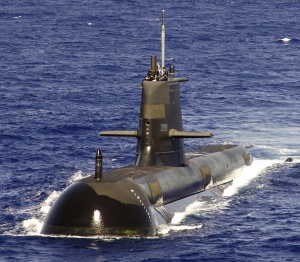
Based at Fleet Base West in Western Australia, HMAS Rankin is the final of the six Collins Class submarines to enter service in the Royal Australian Navy. These submarines are a formidable element in Australia"s defence capability.
Rankin was launched in Adelaide, South Australia by Lieutenant Commander Robert Rankin"s daughter, Ms Patricia Rankin (on behalf of her mother, Mrs Molly McLean) on 7 November 2001 and commissioned at Fleet Base West, Western Australia on 29 March 2003.
HMAS Rankin"s operational characteristics and range have been tailored specifically for its defence and two-ocean surveillance role in the Royal Australian Navy. Designed to be as quiet as advanced technology can achieve, Collins Class submarines have been developed from five generations of submarines designed and built by the Swedish Navy.
One of the first submarines to be totally designed by computers, HMAS Rankin boasts a vast range of features. They include a high-performance hull form, highly automated controls, low indiscretion rates, high shock resistance, optimal noise suppression and an efficient weapons handling and discharge system.
The submarine moves silently on electric power supplied to the propulsion motor by banks of new technology lead-free batteries. The batteries are charged by three onboard diesel generator sets.
The sophisticated combat system gathers its intelligence from its sensors, computes the input and then launches and directs weapons.
Since commissioning, HMAS Rankin has successfully conducted a range of activities throughout the region in support of Australian Defence Force exercises, operations and the government"s strategic directives.
HMAS Rankin is named after Lieutenant Commander Robert William "Oscar" Rankin, RAN who distinguished himself in action during World War II. He commanded the sloop HMAS Yarra (II) and was conducting convoy escort duties in the Northern Indian Ocean when attacked by a Japanese force in February 1942. Facing a far superior force of three heavy cruisers and two destroyers, Rankin gallantly positioned his ship between the Japanese and the scattering convoy vessels. Rankin fought his ship to the very last in an intense exchange. He was killed when an eight inch salvo hit the bridge shortly after passing the order to abandon ship. HMAS Rankin"s motto "Defend The Weak" is testimony to Lieutenant Commander Rankin and Yarra"s determination to defend the unarmed convoy ships.
History of the Crest
The Blazon
Argent; fess wavy of three azure and argent a shield azure, fimbriated gold, charged with an admiralty anchor or, surmounted by an esquire"s helmet proper.
Motif Description
The "Barry Wavy" in blue and white represents the Navy and the sea. In heraldy, an officer in the Navy above the rank of Lieutenant can be called or recognised as an Esquire and an Esquire was also regarded as a shield bearer. In this instance, the Esquire"s helmet represents Lieutenant Commander Rankin as the Esquire, carrying his shield, namely HMAS Yarra and protecting the ships it was escorting from attack by superior Japanese forces in WWII. The anchor on the shield depicts the naval environment of the protection provided by Rankin.
Specifications
 |
| Class |
Collins Class |
|---|---|
| Type |
Guided Missile Submarine, Diesel-Electric (SSG) |
| Pennant |
S78 |
| International Callsign |
VMLR |
| Motto |
Defend The Weak |
| Home Port |
Fleet Base West |
| Builder |
Australian Submarine Corp, Adelaide |
| Laid Down |
12 May 1995 |
| Launched |
7 November 2001 |
| Launched by |
Ms Patricia Rankin (on behalf of her mother, Mrs Molly McLean) |
| Commissioned |
29 March 2003 |
| Dimensions & Displacement | |
| Displacement |
|
| Length | 77.8 metres |
| Beam | 7.8 metres |
| Draught | 7 metres |
| Performance | |
| Speed |
|
| Range |
|
| Complement | |
| Crew |
|
| Propulsion | |
| Machinery |
|
| Armament | |
| Missiles | McDonnell Douglas Sub Harpoon Block 1B (UGM 84C); active radar homing |
| Torpedoes | McDonnell Douglas Sub Harpoon Block 1B (UGM 84C); active radar homing |
| Mines | 44 in lieu of torpedoes |
| Physical Countermeasures | Decoys: 2 SSE |
| Electronic Countermeasures | ESM: Condor CS-5600; intercept and warning |
| Radars | Navigation: Kelvin Hughes Type 1007; I-band |
| Sonars |
|
| Weapon Control Systems | AN-BYG 1. Link 11 |
| Resources | |
| News Articles |
Defence News |
| Image Gallery |
HMAS Rankin |


